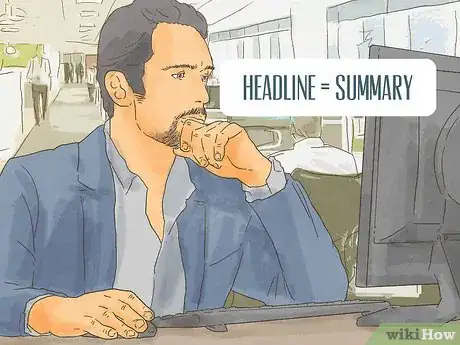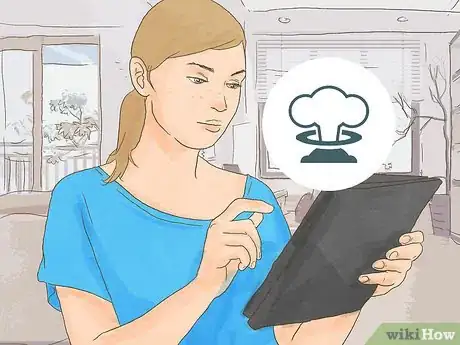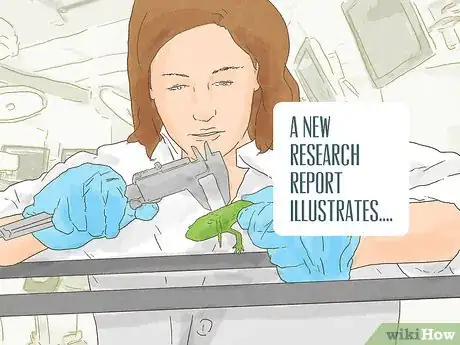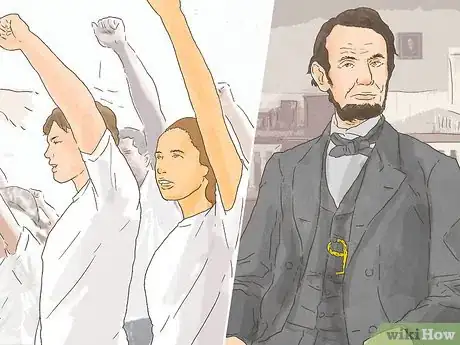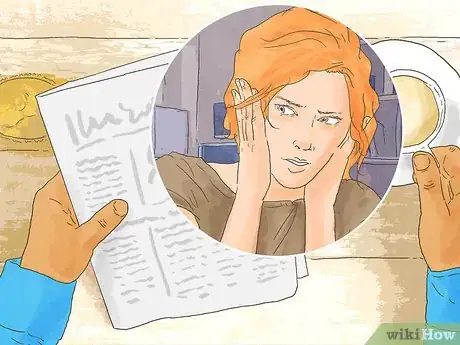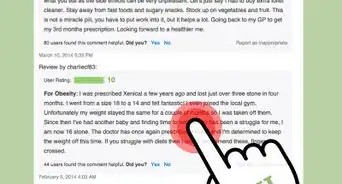This article was co-authored by Christopher Taylor, PhD. Christopher Taylor is an Adjunct Assistant Professor of English at Austin Community College in Texas. He received his PhD in English Literature and Medieval Studies from the University of Texas at Austin in 2014.
There are 8 references cited in this article, which can be found at the bottom of the page.
wikiHow marks an article as reader-approved once it receives enough positive feedback. This article received 11 testimonials and 88% of readers who voted found it helpful, earning it our reader-approved status.
This article has been viewed 127,307 times.
Newspaper articles are written by journalists and reporters to inform the public. News stories report on current events and are usually time-sensitive, so they are written soon after an incident or event has happened. You may analyze the language in newspapers as part of an assignment for a class or as a way to improve your own news-writing skills. Start by looking at the headline of the news article. You can then examine the body of the article to better understand newspaper language, focusing on structure, tense, voice, rhetoric, and tone.
Steps
Evaluating the Headline
-
1Look for nouns and verbs in the headline. Many headlines contain nouns and verbs. Some headlines will have only nouns and no verbs. This is done to keep the headlines short and to the point.[1]
- For example, you may see a headline made up of nouns like, “PM Resignation Over Fraud Charge.”
-
2Check if the headline consists of a string of nouns. In some cases, the headline is a made by stringing 3 to 4 nouns together to make a “noun string.” To better understand a noun string, try reading the headline backwards. Rearrange the nouns into a sentence.[2]
- For example, you may have a headline like “Ford Referral Customer Complaint.” You can then read the headline backward to make a sentence like, “A complaint was made by a customer about a referral program for Ford cars.”
Advertisement -
3Notice if the headline has no articles like “a,” “an,” or “the.” Other phrases that are considered extra, such as “some,” “few,” or “many,” are also usually left out of newspaper headlines to keep them short and to the point.[3]
- For example, you may read a headline like “Neighbor Sees Woman Jump.” If you put articles into the headline, you may get a sentence like, “The neighbor saw the woman jump.”
- Another example is a headline like, “Homeowners Fear New Flooding.” Rather than say “Some homeowners” or “Many homeowners,” the headline just says “Homeowners” to present the most important details.
-
4Look for verb changes in the headline. When verbs appear in headlines, they are usually adjusted to make the headline sound more immediate. Rather than describe the events in the past with a past tense verb, the newspaper will use a present tense verb in the headline.[4] '
- For example, you may read a headline like “Professors Lose Union Fight.” This means the professors lost the fight to start a union, as it just happened in the past.
- The newspaper will also describe events that are going to happen with verbs like “to.” For example, the headline, “Nicolas Cage to Visit Portland” means that the actor Nicolas Cage will be visiting Portland in the near future.
-
5Check for wordplay in the headline. Some headlines have words that can mean two things at once. These words are called puns. Puns and wordplay are often done to give the headline an amusing or entertaining tone.[5]
- For example, you may have a headline like “Otter Devastation.” This is a play on the word “otter” as it can sound like “utter.”
- Another example is the headline, “From Russia...With Gloves.” This headline is a pun on the famous James Bond film, From Russia, With Love and plays on the word “love” by using “gloves.”
-
6Look for alliteration. Alliteration is when the same sound is repeated in a row. Often, headlines that use alliteration consists of words that start with the same letter. Alliteration is used by newspapers to make the headline more catchy and memorable.[6]
- For example, you may have a headline like, “Man Makes Massive Maritime Menagerie.” This uses alliteration with the sound “m.”
- Another example is the headline, “Sleepy Seamstress Sends City Into Century-Long Snooze.” This uses alliteration with the sound “s.”
-
7Ask “who,” “what,” “where,” and “why” when reading the headline. A good newspaper headline will answer at least 1 or 2 of the 4 W's (“who,” “what,” “where,” and “why”). Try answering each of these questions using just the headline of the article.[7]
- For example, you may have a headline like “Man Makes Massive Maritime Menagerie.” The “who” would be a man, the “what” would be a massive maritime menagerie, and the “where” would likely be somewhere near water, as the headline refers to “maritime.”
- Another example would be a headline like “Sleepy Seamstress Sends City Into Century-Long Snooze.” The “who” is a seamstress who sleeps too much, the “what” is a century-long snooze, and the “where” would be a city.
-
8Use the headline to understand the body of the article. The headline should give you direction on what will be discussed in the body of the article. You should refer back to the headline when reading the body, using it as a guide.[8]
- For example, the headline “Eight Dead When Nursing Home Goes Without AC After Hurricane” will tip you off that the article is going to focus on the details of the death of 8 people in the nursing home and how it relates to the hurricane.
Examining the Structure, Voice, and Tense of the Article
-
1Identify where the article is located in the newspaper. Online articles that are straight news stories will be placed in the Current Events or Breaking News section of the newspaper. Articles that are written as opinion pieces or think pieces will be listed in the Op-Ed section of the newspaper. Determining where the article is located will help you know what to expect in terms of the rhetoric and tone of the article.
- For example, an article placed in the Op-Ed section will usually be written from the reporter's perspective or point of view. It may be biased towards a certain position and contain rhetoric that is persuasive and argumentative.
-
2Analyze the lede, or the first line, of the article. The lede of the article is perhaps the most important line in the entire article. It will summarize the story and discuss the who, what, where, when, and how of the story. Identify key words and phrases in the lede that seem important.[9]
- For example, you may read a lede like, “The first evacuee was rushed into the emergency room of Memorial Regional Hospital on Wednesday, escaping a nursing home that had lost air-conditioning in the muggy days after Hurricane Ike.”
- You can then identify key words like “evacuee,” “emergency room,” “nursing home” and “Hurricane Ike.”
-
3Look up unfamiliar words or phrases. Read over the article and circle any words or phrases that you do not recognize. Use a dictionary to look them up so you can better understand them. Then, place the defined word in the context of the sentence so you can understand it better.[10]
- For example, you may be stumped on a word like “evacuee.” You can then look it up and place it in the context of the sentence so you understand the sentence better as a whole.
-
4Check for the active voice. Most newspaper articles use the active voice, where the subject is always the one acting in a sentence or doing an action. This keeps the article immediate and engaging for readers.[11]
- For example, you may read a line in the article like, “Fire and rescue units were hurrying the nursing home's more than 100 residents out.” This is active, as it shows the fire and rescue units doing an action, “hurrying...residents out.”
-
5Determine the tense used in the article. The newspaper article will use the past tense to describe an event that occurred recently, in the past. It will use the present tense to discuss an event that is going to happen in the near future.[12]
- For example, if you have a sentence in the article like, “In all, eight were dead,” this means the article is in past tense.
- If you have a sentence like, “The city plans to open the new walkway next year,” this means the article is the in present tense.
-
6Summarize the article in your own words. Once you feel you have a good grasp on the language used in the article, try writing a 1-2 sentence summary of the article in your own words. Focus on the key details in the article. Use the headline of the article, and the lede, to help you write the summary.[13]
- For example, you may write, “This article is about eight people who died in a nursing home when it lost power during the hurricane. It uses the past tense and the active voice to discuss this event.”
Looking at Rhetoric and Tone
-
1Look for statements that show bias. Check for statements that begin with “I believe” or “I am of the opinion that…” as these are signs the reporter is presenting their point of view. The reporter may also use statements like “I am certain that…” or “It is clear to me that” to show bias.[14]
- The reporter may also show bias by asking rhetorical questions that illustrate their point or argument. For example, they may write, “Why do we need strict laws around abortion in this country?” or “What is the point of spending millions on a new sports arena?”
-
2Identify hyperbolic language. Hyperbolic language exaggerates the reality of a situation so it is more shocking for the reader. Reporters use hyperbolic language to demonstrate their point and grab the reader's attention. They also sometimes use hyperbolic language to give the article a humorous and witty tone.[15]
- For example, you may come across a sentence like, “The mayor would poke his own eyes out before he would allow the new roads to be built.” This is clearly an exaggeration, and the reporter is doing this to keep the reader engaged and demonstrate their point.
-
3Look for clichés. Clichés are phrases that have become so familiar they have lost their meaning. Reporters may use clichés to get a point across quickly and easily to readers. They are also used when the reporter is trying to demonstrate a complicated point in an accessible way.[16]
- For example, you may notice a cliché like, “You can lead a horse to water, but you can't make it drink” in the article. You may then consider what the reporter is trying to demonstrate to the reader by employing this cliché.
-
4Check for evidence or sources used to support an argument. Reporters will use evidence to support an argument. The evidence may be statistics, a quote from a source, or even a graph. They may also get an expert opinion to support their argument.[17]
- For example, you may notice lines that begin with, “According to a new study…,” “A new research report illustrates,” or “Experts predict…”.
- The reporter may also use a quote from a source, such as “'We are doing what we can to contain the situation,' the police chief said at the press conference.”
-
5Identify allusions in the article. Allusions reference well-known works or events in history. Reporters use them to invoke positive or negative feelings from the reader. They may allude to a moment in history to connect a current event with the past.[18]
- For example, a reporter may allude to Dr. Martin Luther King Jr when discussing a rising activist leader in the African-American community. This would then invoke feelings of awe and reverence towards the activist, similar to the way the reader may feel about Dr. Martin Luther King Jr.
-
6Look for inclusive language. The reporter may use inclusive language like “we” or “us” to make the reader feel like they are on the same side as the reporter. Inclusive language makes the reader feel included in the reporter's argument or perspective.[19]
- The reporter may also use exclusive language like “they” or “them” to exclude a group of people. This could make the reader feel like they belong to the “we,” rather than the “they.”
- For example, you may notice a line like, “We may not like it, but the safety of our families is at risk.” Or you may come across a line like, “We stand for freedom and equality, while they stand for hatred and exclusion.”
-
7Determine the overall tone of the article. News articles usually have an authoritative tone. Analyzing the language in the article should help you identify the tone and intent of the reporter. You may decide the tone of the article is:[20]
- Logical, where the article comes across as rational and reasonable. It may use lots of expert opinions and quotes to analyze a situation or event.
- Neutral, where the article is impartial and balanced, with no bias. Most straight news stories are neutral in tone.
- Passionate, where the article is written with a lot of emotion and personality. It may show its bias and argue a certain point by tapping into a reader's emotions.
- Witty, where the article is humorous or satirical. It may come across as lighthearted or tongue-in-cheek. It may try to make the reader laugh by using hyperbolic language and an impersonal or casual approach.
References
- ↑ https://www.thoughtco.com/understanding-newspaper-headlines-p2-1211336
- ↑ https://www.thoughtco.com/understanding-newspaper-headlines-p2-1211336
- ↑ https://www.londonschool.com/language-talk/language-tips/understanding-newspaper-language/
- ↑ https://www.thoughtco.com/understanding-newspaper-headlines-p2-1211336
- ↑ https://www.thoughtco.com/understanding-newspaper-headlines-p2-1211336
- ↑ https://www.londonschool.com/language-talk/language-tips/understanding-newspaper-language/
- ↑ https://www.londonschool.com/language-talk/language-tips/understanding-newspaper-language/
- ↑ https://www.usingenglish.com/articles/how-to-teach-use-language-newspaper-headlines.html
- ↑ http://grammar.yourdictionary.com/grammar-rules-and-tips/tips-for-writing-in-a-newspaper.html
- ↑ https://www.usingenglish.com/articles/how-to-teach-use-language-newspaper-headlines.html
- ↑ http://grammar.yourdictionary.com/grammar-rules-and-tips/tips-for-writing-in-a-newspaper.html
- ↑ http://grammar.yourdictionary.com/grammar-rules-and-tips/tips-for-writing-in-a-newspaper.html
- ↑ https://www.usingenglish.com/articles/how-to-teach-use-language-newspaper-headlines.html
- ↑ https://libguides.lehman.edu/c.php?g=733610&p=5241445
- ↑ http://penandthepad.com/identify-persuasive-manipulative-language-article-essay-4966.html
- ↑ https://study.com/academy/lesson/cliche-definition-examples-quiz.html
- ↑ http://lessonbucket.com/english/year-9-english/persuasive-language/analysing-persuasive-language/
- ↑ http://lessonbucket.com/english/year-9-english/persuasive-language/analysing-persuasive-language/
- ↑ http://lessonbucket.com/english/year-9-english/persuasive-language/analysing-persuasive-language/
- ↑ http://lessonbucket.com/english/year-9-english/persuasive-language/analysing-persuasive-language/
About This Article
The easiest way to analyze newspaper language is to focus on the first sentence of the article, since this sentence summarizes the whole article. Try to find all the important phrases in it to learn the who, what, where, when, and how of the story. Look at the verb tenses as well, since papers use past tense verbs to refer to the recent past, and present tense verbs to refer to the near future. For advice from our English reviewer on identifying different literary devices, scroll down . . .







